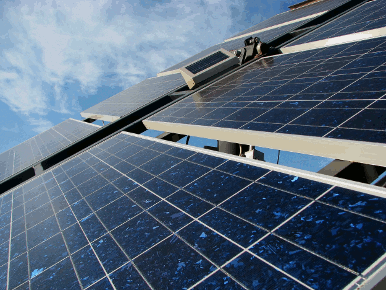Efficiency of Solar Cells and the Materials used to Make them

Picture of Solar Panels by Patrick W. Moore of setsailmedia.com
Often people question how efficient solar cells really are, especially if you're in areas where you're not getting full sunlight, for example in a place like Canada. For terrestrial applications, as opposed to outer space which is another place where photovoltaic cells are utilized, there are a number of products that are commercially used for residential applications. A vast majority of them are based on either multicrystalline silicon or single crystaline silicon. You can tell the diference between these two types by their appearance, with multicrystalline having more shapes and bits in the cell if examined closely whereas single crystal silicon has a very uniform look. Both of these products has a conversion efficiency for converting sunlight to electricity of around 14% to 17%, and the very highest efficient solar cell that you can buy has an effciency approaching 20% for just a module. By the time it gets into a system, the conversion efficiency of the overall unit will drop off a little because there are other parts of the system which themselves are not 100% efficient, so will diminish the efficiency of the entire system. Overall a system efficiency of around 15% is still quite impressive if you're thinking about converting the raw power of light from the sun into usable electric power.
When production of electricity is considered, that is when you have to worry about a location which has less sunlight available compared to a place like sunny Texas for example. In a bright sunny day at noon in the middle of the summer in Canada, properly oriented panels will still produce a terrific amount of power. However, in such a less favourable location the efficiency itself doesn't reduce but what does suffer is the available electricity over the course of a year, because there is less actual solar energy available. This does not necessarily mean that solar power is not affordable in a place like Canada. If it is expensive to buy electricity from the local utility company, or if the electric company has some reason why it wishes to offset their load around peak hours in the middle of summer, they may incentivise people to produce their own electricity around those times. It may then actually be more affordable to have a solar power generating system in Canada than somewhere else.
Solar power is a classic case of something that you may need to shop around or check with an installer who may help with facts and figures. There is also a non-financial reason to put a system that generates electricity from the sun on your own house, which is that over time the more people who do this the more other environmental benefts there can be, which also have a value associated with them which we may discover over the process of time. Most people probably don't make their decisions based solely on money but rather on the idea that the payback period is reasonable, they have looked at the numbers and understand how it will work out for them and they feel like it is also the right thing to do for the long term.
A criticism of solar photovoltaic cells is the amount of energy required in their manufacture. There are questions of when the energy output from the cells exceds the inputs of energy and materials needed in making the solar panels. However, it only takes between one and three years to generate the electricity which would offset what was used to originally produce the photovoltaic device. Therefore if a solar product has an expected 30 year life, which is probably a good estimate taking into consideration the fact that most companies offer a 20 year guarantee, then it's still a good deal for consumers and the planet as a whole.
It could be argued whether those numbers are correct for every single solar device made, but every company who creates photovoltaic products has the natural incentive to make them as efficiently as possible. There is certainly quit a bit of embodied energy in producing the actual silicon products, so a lot of research and development work, for example at the US Department of Energy's National Renewable Energy Laboratory, goes into producing more efficient and effective ways to produce the base material for photovoltaic cells that may not require as much refining and other types of processing. Companies too who produce photovoltaic cells are looking hard at reducing the energy which goes into their production, because this will enable them to save money in the manufacturing process.

Thanks to World House Radio for the inspiration for this feature.
- Renewable Energy:
- Login to post comments

